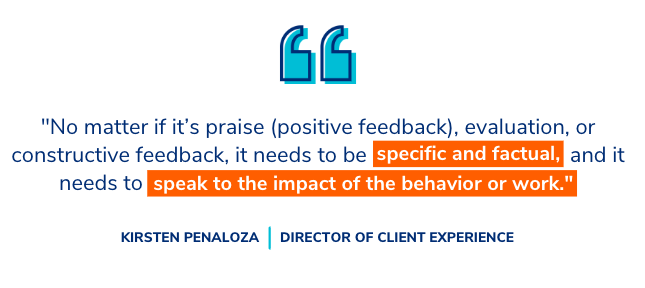Your employees deserve feedback, and as an employer or manager, it’s up to you to give it to them.
Some high-performing employees may not fully grasp how impactful their hard work is for your business. Other employees may not realize that a couple of their bad habits have been dragging the whole team down. And all your employees can use feedback, both positive and constructive, to learn and grow.
Simply put, feedback is crucial for the health of your business and the engagement and retention of your employees.
But many managers and employers find this part of managing people challenging. It can be difficult to know how to give feedback to employees that’s effective and appreciated. To help, we asked CareerPlug leaders to share some of their best advice on giving feedback including some real feedback examples to inspire you.
Why giving employees feedback is important
If feedback doesn’t come naturally to you, you’re not alone. CareerPlug founder and CEO, Clint Smith had to overcome his hesitancy of giving feedback as his business grew:
“In the beginning, I was terrible at giving critical feedback to my employees. Part of it had to do with being a naturally conflict-averse person. The other part is that I would blame myself for their performance issues. I did not set them up for success — at least, that was the story that I told myself.
Then one day, I got called out by one of my leaders. He told me that I owed him feedback and that was the only way that he was going to get better. He was totally right.”
One employee in our Toxic Work Environment Report, shared a similar frustration with a lack of feedback at work: “It’s challenging when there’s no positive feedback for putting in effort, and you go unnoticed by team leads for trying to go above and beyond expectations.”
It’s clear that employees want feedback. Feedback helps employees stay motivated and engaged at work. This is important since engaged employees perform better. One study found that 71% of managers believed that employee engagement is one of the most important factors contributing to overall company success.
Employee development is another huge factor in employee retention and engagement. In our survey, we found that the number one change employees would like to see was “more opportunities for growth” to create a more positive workplace. Feedback helps employees understand their strengths and their opportunities for growth. It helps people understand their bigger purpose in the company and how the company can help them reach their goals.
Tips for giving employees feedback
As a busy manager or employer, it can be difficult to make time for giving feedback to your employees. It can also feel intimidating and awkward to have conversations with employees around their performance. However, it’s crucial to set aside the time to do so.
Though scheduling twice yearly or quarterly performance reviews is a good idea, in general, you should make feedback an ongoing habit, and not feel obligated to wait till those meetings to let employees know how they’re doing. Clint Smith shares:
“I don’t wait until formal performance reviews to deliver feedback. We do them twice a year, and I put a lot of energy into them. But most of it is feedback — positive or negative — that I have already shared with my employees. My goal is for there to be no surprises when I give the reviews. I usually give my feedback during our weekly one-on-one meetings or directly after an event that created new feedback. If it’s positive feedback, I will praise people in front of their peers. If it is negative, then I will pull them aside and address it as soon as possible.”
Whether you are giving employees feedback during a performance review or on the fly, keep in mind that all feedback needs to be detailed. As Kirsten Penaloza, Director of Client Experience at CareerPlug, puts it, “No matter if it’s praise (positive feedback), evaluation, or constructive feedback, it needs to be specific and factual, and it needs to speak to the impact of the behavior or work (good or bad).”

How to give positive feedback
Though positive feedback is typically an easier pill to swallow for employees, it still takes finesse to present it correctly. It’s also important to make positive feedback something employees can expect consistently.
Natalie Morgan, Senior Director of People, thinks positive feedback more often can limit the amount of constructive feedback you have to give. She shares:
“I buy into the idea that we should focus on helping others make their strengths stronger, rather than dwelling on weaknesses. To do that, you need to give specific, positive feedback more than negative feedback.”
Positive feedback examples
CareerPlug leaders all agree that when it comes to feedback, specificity is key! Check out the following examples of this in use:
From Natalie Morgan: “Saying ‘good job!’ may be appreciated, but it doesn’t reinforce what about their behavior was good. Instead, you might say ‘You asked great questions during that meeting that showed me you were engaged and really thinking about how to solve the problem. Keep it up!”
Kirsten Penaloza: “I see managers often say things like ‘Great work!’ and offer no other insight into what was great, which doesn’t reinforce the good things (skills, tasks, behavior, action items) of the person. I always make a point of saying something along the lines of ‘You did an excellent job with your presentation by being precise, and you communicated clearly your points with on-point visuals and convincing arguments. This will help your teammates understand the importance of the topic, how it relates to the company goals, and it’ll make it easier to implement new ideas.’”
How to give constructive feedback
Encouraging employee performance with positive feedback can limit the amount of constructive feedback you have to give, but there will still be times when you have to provide tougher assessments to your employees. Keep in mind, though difficult, this feedback is what helps your employees grow.
And as Morgan reminds us, you need to be specific when dishing out this kind of feedback as well: “Constructive feedback is also necessary for growth. I like the SBI model: Situation, Behavior, Impact. Name the situation (when was this, what was happening), the behavior (what did this person do or say), and the impact it had.”
Penaloza shares her most effective methods for delivering constructive feedback:
“Constructive feedback is often tougher to deliver, therefore, it depends on the situation of how I handle it. I usually have two approaches, one is more directive and I use it when I need to see immediate corrective changes, the other is more coach-based and focused on future strength-based behavior.
For the first one, my framework is always the same, I state the behavior, observation, or issue with just facts and using “I” statements. I explain the impact of the behavior or issue, such as the impact on the team, the performance or work, the company, etc.. I set expectations, e.g. what I need to see differently moving forward.
For a more coaching approach, which is more about asking questions and being less directive, I name the observation but then ask more thought provoking questions like:
- What do you think your peers believe when they see you do/say this?
- What is the impact your behavior might have on others or your own?
- Can you think of some ways you can do things differently to have a more positive result?
- How would you feel if you were observing this in others?
By using a more coaching approach, I usually see that the other person gains insights without me having to actually deliver the feedback and they come up with their own answers to change the behavior, which is very impactful and extremely positive in the work environment.”
Constructive feedback examples
Clearly, the Situation, Behavior, Impact model (or variation of it) can help you deliver the difficult truth to your employees. Let’s see this in action.
From Morgan: “Yesterday in our team meeting (Situation), Tori presented her idea and you called it stupid and rolled your eyes (Behavior). Tori stopped contributing after that and it made me feel like I couldn’t share my own ideas without risking ridicule (Impact).”
Penaloza:
“I noticed in our meetings you sit leaned back with crossed arms and you seem very quiet.” (Behavior)
“This can leave the impression that you are not interested in the topics we’re discussing as a team, hence, you’re not being part of the solution and the buy-in, which in return can cause your teammates to disengage with you and for you to alienate yourself from your team.” (Impact)
“Moving forward, I really would like to see a more engaging, positive body language, and for you to actively and proactively engage in the meeting by sharing your thoughts, ideas, and concerns.” (Expectations)
Tying feedback to your core values
CareerPlug President, Jenny Leman, says the best way to structure your feedback and make it more powerful is to relate your feedback to your core values.
“As a leader, I’m a huge fan of really staying disciplined on tying feedback to a core value. I believe, if a company sets the right core values, those can be used to drive and incentivize the right behaviors that work for the organization.”
When discussing CareerPlug’s own core values, Leman explained: “I have yet to name a situation where we needed to give feedback (either positive or negative) and couldn’t tie it back to our core values. We use our core value document for quarterly conversations and real time feedback. We can always go back to the way our core values are worded and how we expect them to be lived out.“
She sums it up by saying, “If an organization can always lean on their core values for any type of feedback, it emphasizes the meaning of the core values, makes the feedback super clear, and takes away any subjectivity.”
As a bonus, structuring your feedback around your core values is the perfect “pressure test” that helps you check in with what your values are and whether they are still working for your business.
The right core values equal more meaningful feedback for your employees and a strong company culture.
Accepting feedback from employees
Not only should you be regularly giving employees feedback, you should also create an environment where they feel comfortable letting their voice be heard, since your employees’ feedback is incredibly valuable for creating a great workplace and enabling your business to reach its full potential.
Clint Smith shares his best tips for accepting feedback from employees: “Make sure that you have created open channels so that you can receive feedback. Ask people how you are doing and what you can do to improve. If you never get any constructive feedback, then you have not built enough trust with your team. You need their feedback to grow.”
Feedback is a two-way street between leadership and employees that is mutually beneficial. Your employees deserve to be praised for their contributions and to be given the opportunity to grow from their mistakes or weaknesses. Feedback (especially when tied back to your core values) contributes to a growth culture and is powerful not only at the individual level, but for the whole business.


























